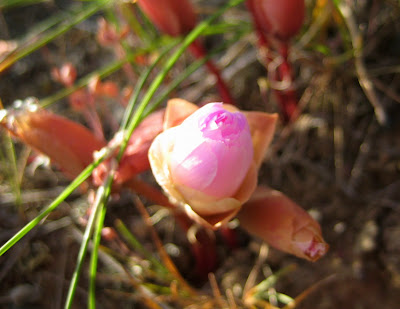I was in search of Bitterroot blossoms. It was dawn and I had never seen the flower, it grows mostly in Western Montana and parts of Idaho. I knew I would know it when I saw it. I felt that way once before. I was in the Louvre in Paris, looking for a statue called The Slave by Michelangelo. I had never seen a picture of it, but had read a book about Michelangelo's work. Lost, I wandered from room to room. As I entered a new room, I saw a white marble statue from the back. Without sign or even full form I knew that this was indeed the piece I was searching for. That's how I felt about Bitterroot. I desperately wanted to see it, for reasons that are hard to put into words--I felt I would understand this place (and in it my place) better. I found some buds, watched the sun creep over the mountains, and waited for the petals to unfurl.
The blossom is beautiful--a delicate pink--and grows out of the most unforgiving, rocky soil. It would be spectacular anywhere, but is especially breathtaking given its unlikely location. Bitterroot's scientific name is Lewisia rediviva. Lewisia after Meriwether Lewis of the Lewis and Clark expedition who found and named it. Rediviva because the plant is legendary for being able to live without water for over a year. It is sometimes called the "resurrection flower": it symbolizes strength and beauty under almost impossible conditions. The leaves appear first, looking a little like green anemones, then they die and the blossom appears alone in the rocky soil. I imagined the Lewis and Clark expedition traveling not far from where I stood. I imagined Lewis's wonder as he saw the blossoms appearing underfoot.
One Native legend tells the origin of the plant. A mother was crying because she could not find food for her children. The sun heard her cries and changed her tears into the Bitterroot so that she would always have food for her family.
I gently touched the petals--aglow with the morning sun. I pondered new hopes, second chances, perseverance, and new life found in unexpected, difficult places.
Sources: http://www.50states.com/flower/montana.htm, http://www.wildflowerinformation.org/wildflowerfolklore.asp, http://ezinearticles.com/?The-Resurrection-Flower---Montanas-Bitterroot-Wildflower&id=886513









3 comments:
I love wild flowers they seem so much more stalwart and tenacious and less pansy like. Even though Pansies aren't exactly pansies themselves. Did you take all the pictures on this post, especially the first one?
Yes, these were my pictures. Thanks for admiring them. I am pretty proud of them myself.
Amen on the good pictures. I'm looking forward to seeing you soon so we can catch up and talk again.
Post a Comment